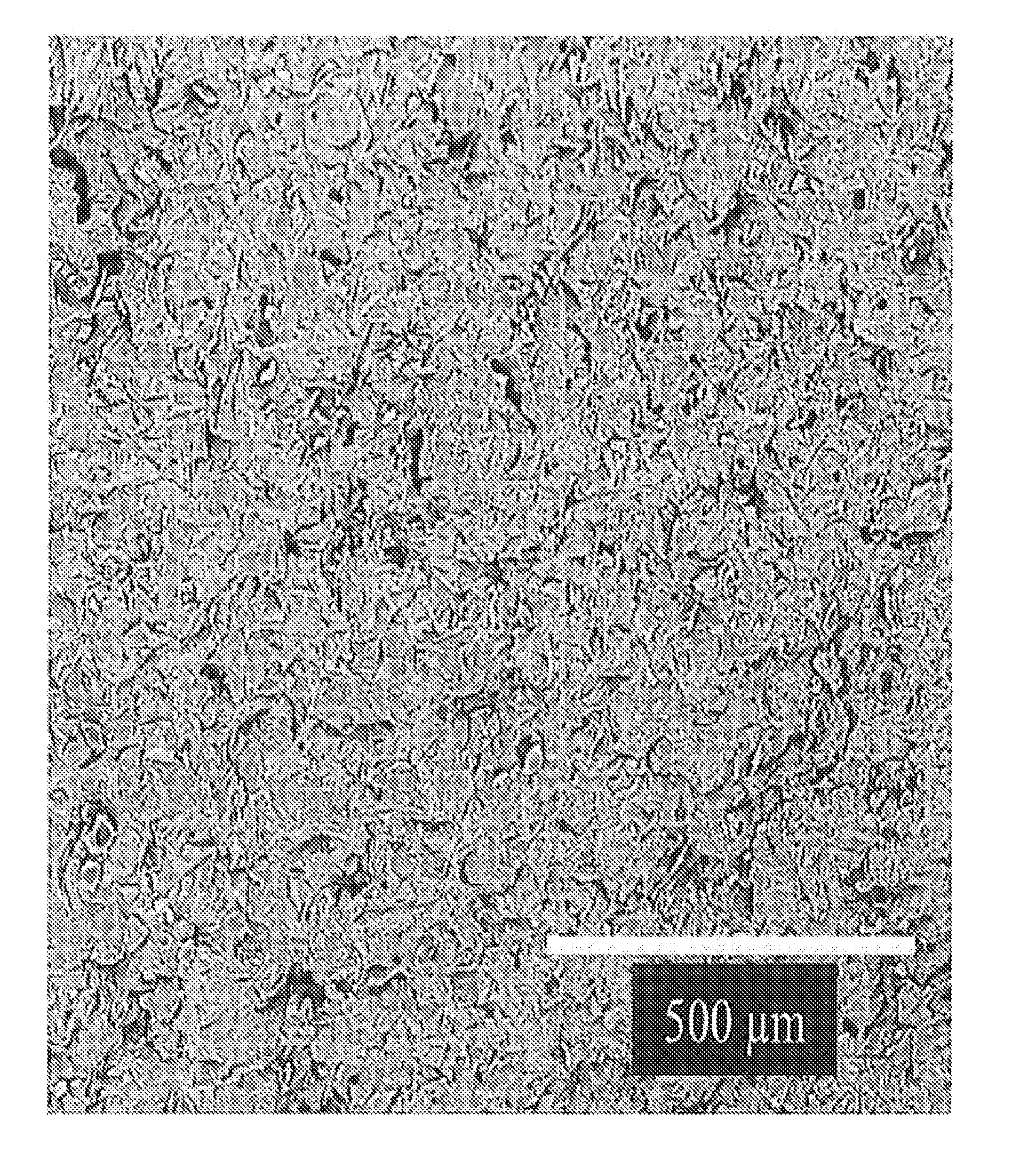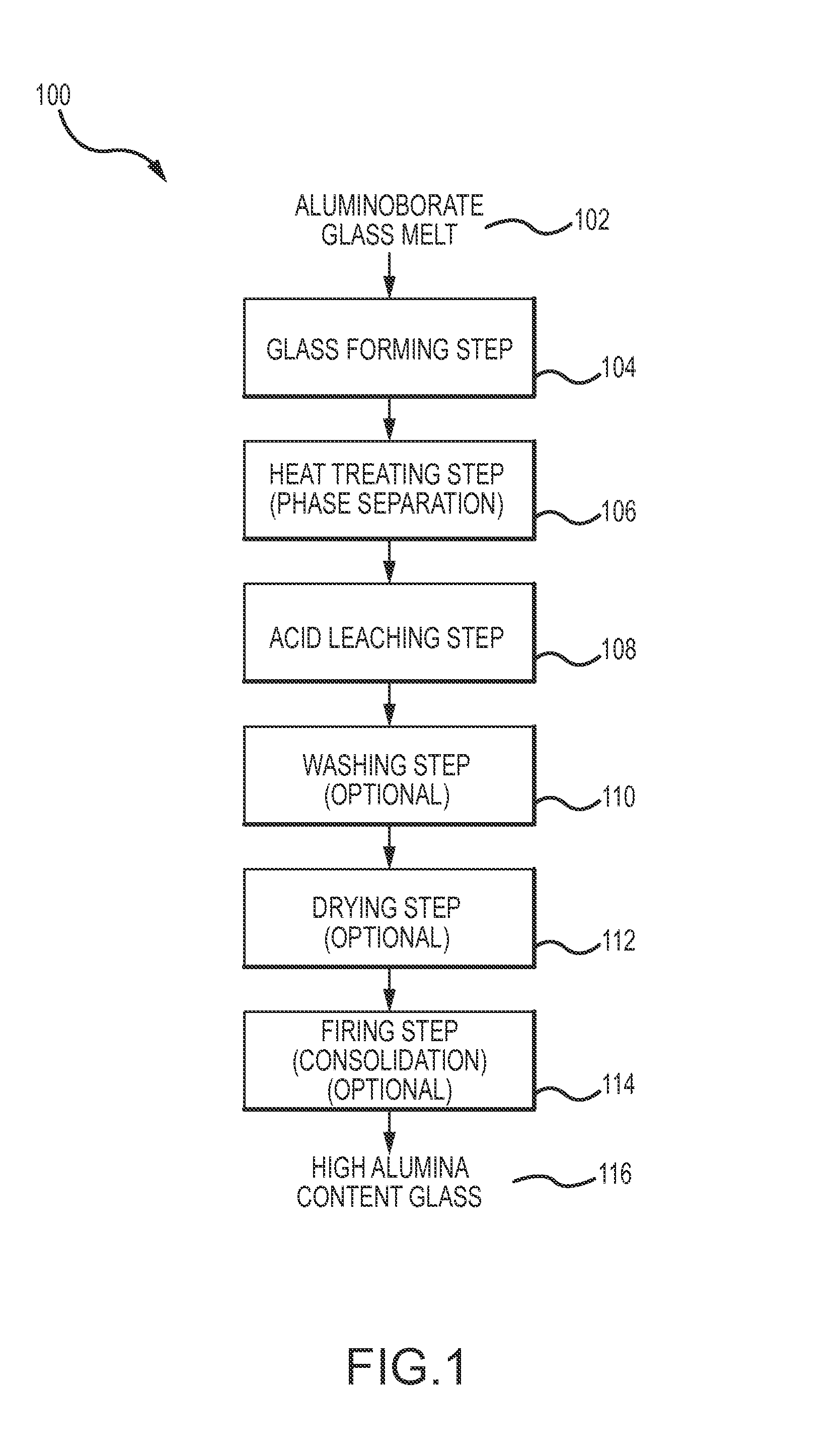Alumina-rich glasses and methods for making the same
a technology of alumina-rich glasses and glass, which is applied in the field of new glass formulations, can solve the problems of high capital and operating costs, degradation of glass properties, and high cost of everyday use, and achieve the effects of high alumina content glass
- Summary
- Abstract
- Description
- Claims
- Application Information
AI Technical Summary
Benefits of technology
Problems solved by technology
Method used
Image
Examples
example 1
[0057]Table 1 illustrates ray diffraction (XRD) data for NAB and R2RAB based glasses made with the invention. The glass compositions are reported as approximate mol % as calculated from batches for melting the glasses. The x-ray diffraction (XRD) data for NAB and R2RAB based glasses of Table 1 are illustrated in FIG. 2. These data demonstrate that NAB 006 is amorphous, and therefore a glass.
TABLE 1890NABNABNABNABNABOxides890 GUFGUG003009006008005Glass HGlass IAl2O3162033.3332528.5740405050B2O338.634.633.3335042.8645403040Na2O6633.3342528.57152000P2O51.71.7000002010K2O7.97.90000000MgO7.77.70000000CaO22.122.10000000
example 2
[0058]In a typical glass research procedure, batches for the above glasses are compounded, mixed, and melted in alumina, quartz, or platinum crucible at 1400° C. The melts are then cast into glass ingots and annealed at about 500-600° C. to provide stress-free castings. Table 3 lists compositions made for the Al2O3—B2O3—P2O5+RO+R2O system. FIG. 2 illustrates XRD patterns for NAB and 890 glasses. The composition of alumina with content above 40 mol % (for NAB 002 and NAB 005) as illustrated in FIG. 2A present some crystalline peaks while the composition with alumina content between about 25 mol % and about 33 mol % of alumina are amorphous. The “*” illustrates α-alumina. FIG. 2B illustrates XRD patters of R2RAB based glass compositions showing amorphous nature of these glasses.
Structural Identification
[0059]Samples from the as-annealed glasses were characterized using XRD to verify the amorphous nature of these materials. XRD was carried out using a Philips X'Pert Pro MPD Diffractome...
example 3
[0063]ICP data for a control sample of bioglass (890GUC) and a glass made with the invention (NAB 006) was gathered and listed in Table 3. The units for the values in Table 3 are wt. % and are approximate values.
TABLE 3890 GUCNAB 006OxideBatchedICP1ICP2OxideICP 2NormalizedSiO20.20.770.0000Al2O35.965.675.4837.9933.1033.52Fe2O30.020.0220.0100.010.01MgO4.534.765.0700.010.01CaO18.0918.321.0000.030.03Na2O5.414.985.1323.0925.2025.52K2O10.869.9911.5000.010.01P2O53.523.714.6700.400.41SrO000.0500.000.00ZrO2000.0100.000.00B2O351.4151.345.6038.9140.0040.50Total10099.509.5299.9998.76100
The NAB 006 glass contained over 30% alumina, while the control bioglass contained less than 6% alumina.
PUM
| Property | Measurement | Unit |
|---|---|---|
| Temperature | aaaaa | aaaaa |
| Temperature | aaaaa | aaaaa |
| Temperature | aaaaa | aaaaa |
Abstract
Description
Claims
Application Information
 Login to View More
Login to View More - R&D
- Intellectual Property
- Life Sciences
- Materials
- Tech Scout
- Unparalleled Data Quality
- Higher Quality Content
- 60% Fewer Hallucinations
Browse by: Latest US Patents, China's latest patents, Technical Efficacy Thesaurus, Application Domain, Technology Topic, Popular Technical Reports.
© 2025 PatSnap. All rights reserved.Legal|Privacy policy|Modern Slavery Act Transparency Statement|Sitemap|About US| Contact US: help@patsnap.com



